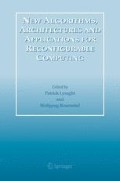Abstract
This chapter presents the effects of polynomial degrees on the hierarchical segmentation method (HSM) for approximating functions. HSM uses a novel hierarchy of uniform segments and segments with size varying by powers of two. This scheme enables us to approximate non-linear regions of a function particularly well. The degrees of the polynomials play an important role when approximating functions with HSM: the higher the degree, the fewer segments are needed to meet the same error requirement. However, higher degree polynomials require more multipliers and adders, leading to higher circuit complexity and more delay. Hence, there is a tradeoff between table size, circuit complexity and delay. We explore these tradeoffs with four functions: \(\sqrt { - \log (x)} \), x log(x), a high order rational function and cos(πx/2). We present results for polynomials up to the fifth order for various operand sizes between 8 and 24 bits.
Access this chapter
Tax calculation will be finalised at checkout
Purchases are for personal use only
Preview
Unable to display preview. Download preview PDF.
References
J. Cao, B.W.Y. We and J. Cheng, “High-performance architectures for elementary function generation”, Proc. 15th IEEE Symp. on Comput. Arith., 2001.
J.N. Coleman, E. Chester, C.I. Softley and J. Kadlec, “Arithmetic on the European logarithmic microprocessor”, IEEE Trans. Comput. Special Edition on Comput. Arith., vol. 49, no. 7, pp. 702–715, 2000.
D. Das Sarma and D.W. Matula, “Faithful bipartite rom reciprocal tables”, Proc. IEEE Symp. on Computer Arithmetic, pp. 17–28, 1995.
H. Henkel, “Improved Addition for the Logarithmic Number System”, IEEE Trans. on Acoustics, Speech, and Signal Process., vol. 37, no. 2, pp. 301–303, 1989.
C.L. Lawson, “Characteristic properties of the segmented rational minimax approximation problem”, Numer. Math., vol. 6, pp. 293–301, 1964.
D. Lee, W. Luk, J. Villasenor and P.Y.K. Cheung, “A hardware Gaussian noise generator for channel code evaluation”, Proc. IEEE Symp. on Field-Prog. Cust. Comput. Mach., pp. 69–78, 2003.
D. Lee, W. Luk, J. Villasenor and P.Y.K. Cheung, “Hardware function evaluation using non-linear segments”, Proc. Field-Prog. Logic and Applications, LNCS 2778, Springer-Verlag, pp. 796–807, 2003.
D. Lee, W. Luk, J. Villasenor and P.Y.K. Cheung, “Hierarchical Segmentation Schemes for Function Evaluation”, Proc. IEEE Int. Conf. on Field-Prog. Tech., pp. 92–99, 2003.
D.M. Lewis, “Interleaved memory function interpolators with application to an accurate LNS arithmetic unit”, IEEE Trans. on Comput., vol. 43, no. 8, pp. 974–982, 1994.
O. Mencer, N. Boullis, W. Luk and H. Styles, “Parameterized function evaluation for FPGAs”, Proc. Field-Prog. Logic and Applications, LNCS 2147, Springer-Verlag, pp. 544–554, 2001.
J.M. Muller, Elementary Functions: Algorithms and Implementation, Birkhauser Verlag AG, 1997.
A.S. Noetzel, “An interpolating memory unit for function evaluation: analysis and design”, IEEE Trans. Comput., vol. 38, pp. 377–384, 1989.
J.A Piñeiro, J.D. Bruguera and J.M. Muller, “Faithful powering computation using table look-up and a fused accumulation tree”, Proc. 15th IEEE Symp. on Comput. Arith., 2001.
M.J. Schulte and J.E. Stine, “Symmetric bipartite tables for accurate function approximation”, Proc. 13th IEEE Symp. on Comput. Arith., vol. 48, no. 9, pp. 175–183, 1997.
J.E. Stine and M.J. Schulte, “The symmetric table addition method for accurate function approximation”, J. of VLSI Signal Processing, vol. 21, no. 2, pp. 167–177, 1999.
Author information
Authors and Affiliations
Editor information
Editors and Affiliations
Rights and permissions
Copyright information
© 2005 Springer
About this chapter
Cite this chapter
Lee, DU., Luk, W., Villasenor, J.D., Cheung, P.Y. (2005). The Effects of Polynomial Degrees. In: Lysaght, P., Rosenstiel, W. (eds) New Algorithms, Architectures and Applications for Reconfigurable Computing. Springer, Boston, MA. https://doi.org/10.1007/1-4020-3128-9_24
Download citation
DOI: https://doi.org/10.1007/1-4020-3128-9_24
Publisher Name: Springer, Boston, MA
Print ISBN: 978-1-4020-3127-4
Online ISBN: 978-1-4020-3128-1
eBook Packages: EngineeringEngineering (R0)

